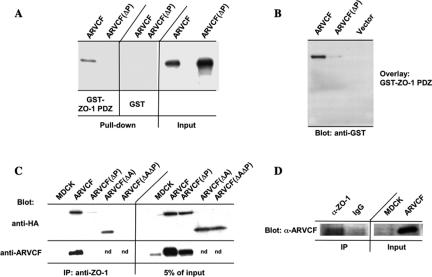Figure 2.
Binding of ARVCF and ZO-1. (A) In vitro-translated ARVCF binds to a GST fusion protein containing the PDZ domains of ZO-1. GST or GST-ZO-1 PDZ fusion proteins were coupled to glutathione beads and incubated with in vitro-translated, radioactively labeled ARVCF or ARVCF(ΔP). Protein bound to the beads (pull-down) was analyzed by SDS-PAGE and autoradiography. An aliquot (5%) of the in vitro translated material was directly analyzed to confirm that similar amounts of the in vitro-translated proteins were added to the binding reaction. (B) ZO-1 PDZ domains bind directly to ARVCF in blot overlays. In vitro-translated ARVCF or ARVCF(ΔP) were fractionated by SDS-PAGE, transferred to PVDF membranes, and incubated with ZO-1 PDZ domains fused to GST. Bound GST-ZO-1 PDZ was detected with a labeled anti-GST antibody. (C) ARVCF coprecipitates with ZO-1 from transfected MDCK cells. Control cells (MDCK) or cells expressing ARVCF, ARVCF(ΔP), ARVCF(ΔA), or ARVCF(ΔAΔP) were lysed and equal amounts of total protein used to immunoprecipitate ZO-1. Precipitates were blotted to detect ARVCF (anti-HA and anti-ARVCF) that was bound to ZO-1. An aliquot of the cell lysate (5%) was directly blotted to determine the amount of wild-type and mutant ARVCF present in the lysates. Untransfected cells served as a control for the specificity of the precipitation; nd, not determined. (D) Endogenous ARVCF and ZO-1 coprecipitate from MDCK cells. Endogenous ZO-1 was immunoprecipitated from lysates of MDCK cells and precipitates were analyzed by Western blot by using an anti-ARVCF antibody to detect associated ARVCF. Beads coated with an irrelevant antibody (IgG) failed to precipitate ARVCF. An aliquot of the MDCK cell lysate (5%), or for comparision cells transfected with ARVCF, was directly blotted. Approximately 20× the amount of protein used in C was used for the coprecipitation of endogenous proteins.

